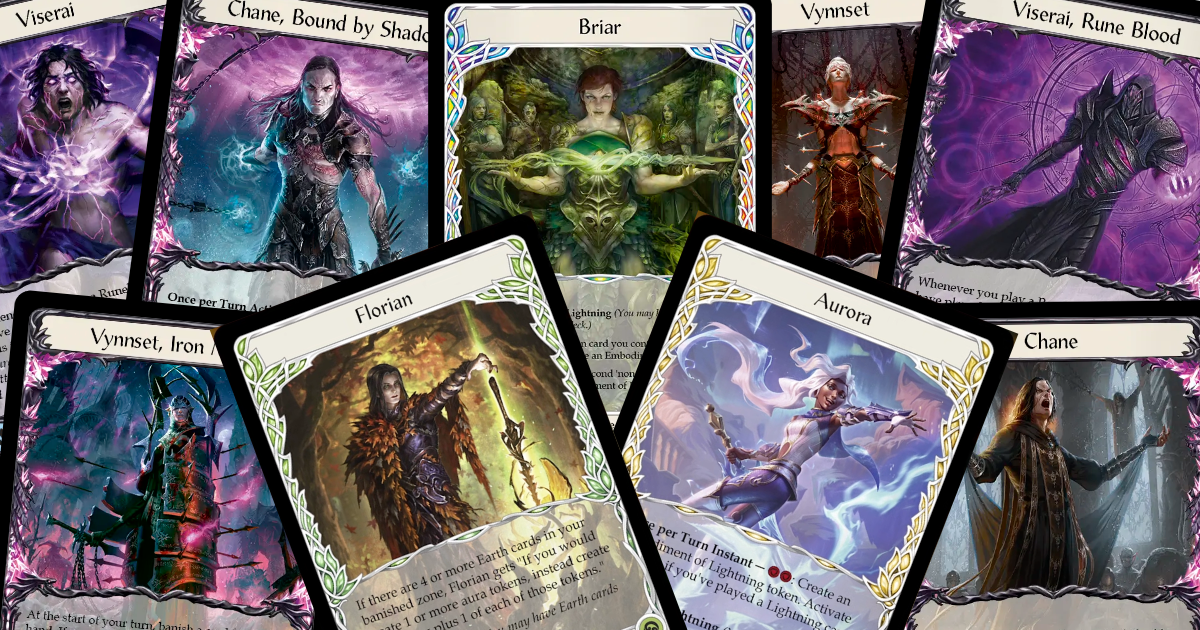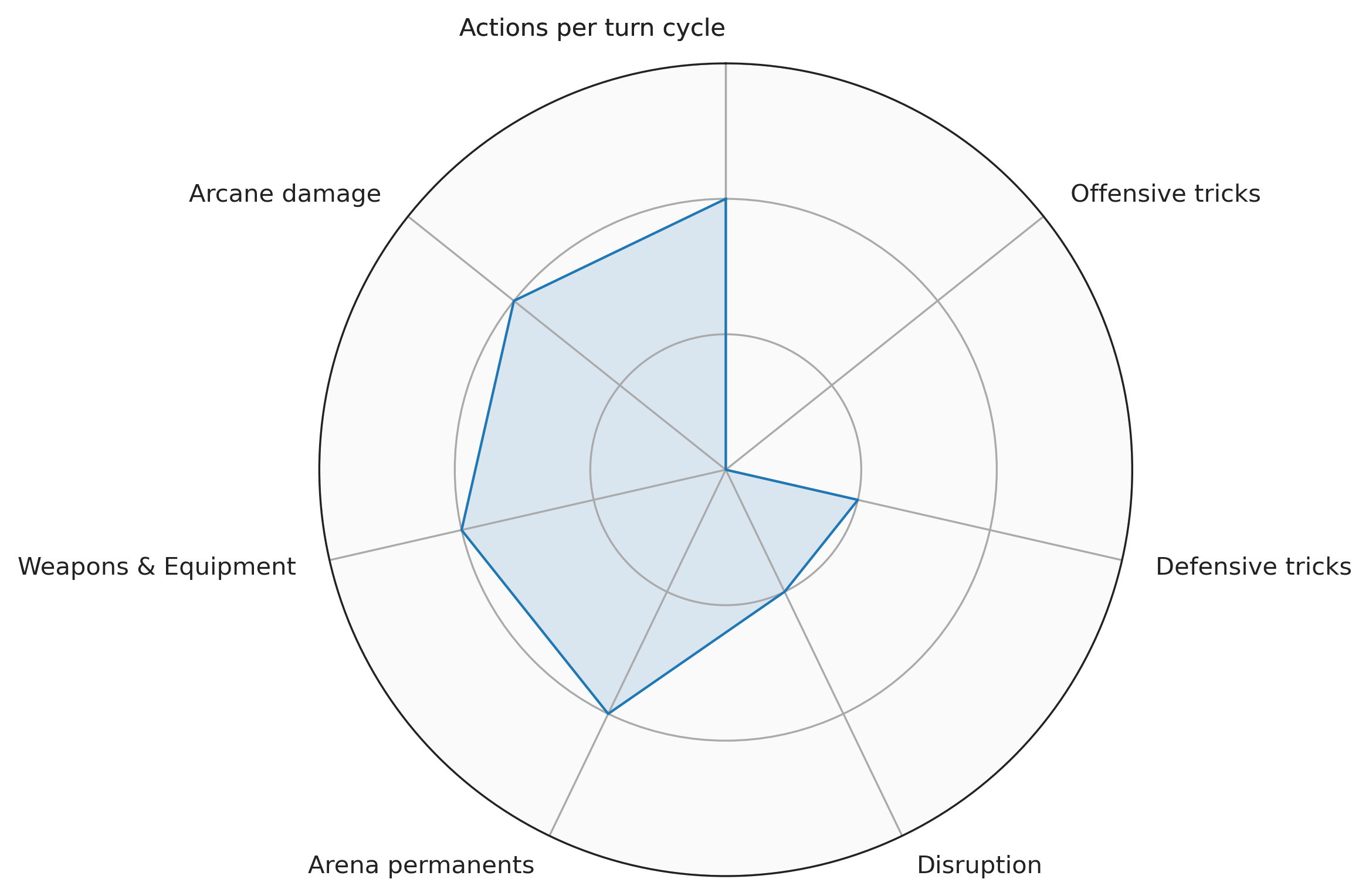ClassID - Runeblade
As the year 2021 drew to a close after the release of Tales of Aria, the aggro side of Flesh and Blood’s constructed meta was mostly dominated by a single class: Runeblade. These arcane knights, battlemages, wielders of sword and sorcery, and heroes of might and magic were the true boogeymen of the format. Leading the charge were Chane, disciple of the Demonastery, and Briar, protector of Candlehold. Both heroes have long since attained the Living Legend status in Classic Constructed, and Shadow Runeblade has already re-entered the format after a year of absence in the form of Vynnset, albeit with a strongly altered playstyle. Lately, the two remaining Runeblades, Viserai and Vynnset, have not really been in the spotlight, but maybe this will change in the near future. With the announcement that the set Rosetta will introduce two new Elemental Runeblades, effectively splitting Briar’s designated card pool across two heroes, the time seems right to talk about Runeblades as the first arcane-wielding class in this series.
Sword & Sorcery
Do you like the idea of wielding both blade and spell? Of charging in with a sword whilst blasting your opponent with arcane energy from the flank? Then Runeblade is probably the right class for you. Like Warriors, Runeblades enter battle with a strong suite of armour, but rather than focusing on making their attacks connect, they supplement their weapon strikes with a sprinkle of arcane damage, often in the form of Runechants. Contrary to physical damage, which can be blocked by any card with a value in the bottom right corner, arcane damage requires your opponent to equip special equipment just to have the opportunity to defend against it, most commonly in the form of arcane barrier. Hence, it is already likely that you are disrupting the ideal loadout for their gameplan just by the nature of your class. On top of that, splitting your attacks across physical and arcane damage makes it much harder to prevent all damage. Whereas an attack for 6 could be blocked cleanly with two 3-block cards, presenting 6 damage as 4 physical and 2 arcane damage makes that impossible with those same cards.
But alas, like many good things in life, this power does not come freely. The sacrifice you have to make as a Runeblade player lies in variance. As evidenced by Runechants, arcane damage in the Runeblade class is tied to attacking, but the effects that create Runechants or turn on your arcane damage effects, like Rosetta Thorn’s (Rest In Living Legend), are relegated to ‘non-attack’ actions. Essentially, this means your deck will feature both attack and non-attack actions, preferably in equal measures for cards like Sonata Arcanix or even Tome of the Arknight, but this consequently opens you up to ‘brick hands’, i.e. hands full of either attacks or non-attacks, with no synergy to reach any level of respectable damage output.
Luckily, it is not all doom and gloom when you are faced with a hand full of non-attack actions. As you might have noticed, Runechants are auras, meaning that they stick around in the arena until their triggered condition is met. Creating auras and thus accumulating value across turn cycles is a feature that all Runeblades that we have seen so far, share. Viserai and Vynnset create Runechants, which don’t only deal damage, but also act as discount vouchers for certain attacks like Amplify the Arknight and rune gate cards, allowing you to build value one turn and cash it in on the next one. Similarly, Chane accumulates Soul Shackles at a rate of one per turn, which may seem terrible at first glance, until you realise that many Shadow cards can be played from your banished zone and shackles effectively increase your hand size. Finally, Briar has two signature auras, one of which she makes by embracing the saying “offence is the best defence” and one that allows her to convert these non-attack hands into a wider turn later on. Remember: value across turns.
Finally, it is worth noting that unlike Ninja cards, most Runeblade attack actions do not feature go again. This may lead you to believe that the class is all about accumulating value on the board as Runechants to set up huge, singular attacks (and you definitely can!), but Runeblades can actually play wide turns too. Just look at Chane’s ability, which tacks on go again for free, or Briar’s Embodiment of Lightning. This is further made possible by the allstar non-attack Mauvrion Skies (which comes in all three colours), or the fact that non-attack actions with go again resolved at instant speed give an action point, which is exploited by cards like Rattle Bones and Spellbound Creepers. All of this leads to a flexible class, that can be built to go tall or wide, as per the player’s preference. And that is exactly how I expect Rosetta to shake out: one go-tall and one go-wide Runeblade.
Runeblade’s radar chart
With the playstyle description out of the way, let us have a look at how Runeblade scores on the generic metrics.
Rather than starting at the top, as usual, let us start one trait to the left of the top, considering it is probably the most important one to talk about. Then proceeding clockwise, I present some motivation for each score here.
- Of the three current classes that have access to arcane damage, Runeblade ranks in the middle of amount of arcane damage each class has access to. Until the release of the game’s second Runeblade in Monarch, each source of arcane damage only dealt a singular point. Now, the cap seems to be at 2 points of arcane damage, with cards like Vexing Malice and Invert Existence. However, we already know that the upcoming Runeblade Florian will be able to play at least one card with amp 3, increasing this cap to 5. This is still nowhere near Wizard’s ceiling, so Runeblade comes in at a 2 in this category.
As already pointed out in the general overview above, Runeblades can both play tall and wide. However, even if they are not committing to a wide turn, it often occurs that they want to play a non-attack and an attack action. Therefore, I am ranking the number of actions per turn cycle at a 2 as well due to the tendency to take more than 1 action, with a potential for wide turns.
Though there are similarities between Runeblade and Warrior, the offensive tricks category is definitely the one where the disparity between the two is greatest. Whereas Warrior has a lot of tricks in the bag for the reaction step, Runeblades generally operate under the motto “what you see, is what you get”. The class has no attack reactions, and their instant speed shenanigans pertain to reacquiring an action point or creating auras, which only affect whatever comes later. Though there is some wiggle room with cards like Swarming Gloomveil and Shrill of Skullform combined with aura creation via Spellbound Creepers, I don’t think these interactions warrant a point in this category, as all the effect are already face-up on the table here.
- If you plan to build a stack of Runechants whilst you defend however, the class has some options. Aside from the defence reactions Reduce to Runechant and Sigil of Suffering that both net you a point of arcane damage, you have a few more exotic defensive tools as well, like Runeblood Barrier and Amethyst Tiara. Definitely worth a point in my book!
- As you probably have gathered by now, this class’s strength lies in split damage and a bit of instant speed trickery. To balance things out, disruption is not one of its core strength. I would say Runeblade has enough disruption cards to earn them 1 point in this category, like Consuming Volition and Reek of Corruption, but their options remain rather limited.
- Arena permanents, on the other hand, are quite a strength, mostly in the form of token auras like Runechants and Embodiments, though they are mostly limited to single (turn) use. Furthermore, there are a few non-token auras in the card pool, like the Runeblood Barrier mentioned above, the popular Runeblood Incantation, and the inevitable Looming Doom.
- And finally to wrap up this section, let’s talk equipment and weapons. Like Warriors, Runeblades have a few great blocking pieces, most notably Grasp of the Arknight, and like Wizard a few amazing utility pieces, like Spellbound Creepers. Hence, their equipment is quite fine. However, aside from the long-gone Rosetta Thorn, their weapons have not been stellar, which limits my score here to a 2.
Who is the Runeblade class for?
So where does this leave us? This class is for people who like to attack on two different axes, the physical and the arcane, and are willing to accept the variance that comes with including two types of cards in their deck to do so (attack vs non-attack). This class is also for those who love to see the rising dread in their opponent’s eyes as you build a board of Runechants to unleash all hell in a single one-turn kill (OTK). And finally, this class is for players who like options. Any given hand can likely be played in a variety of ways, and ultimately, this is why I love the class.
If you enjoyed this article, please share this series with the new players in your locals, such that they can make an informed decision on which deck they want to compete with next.

